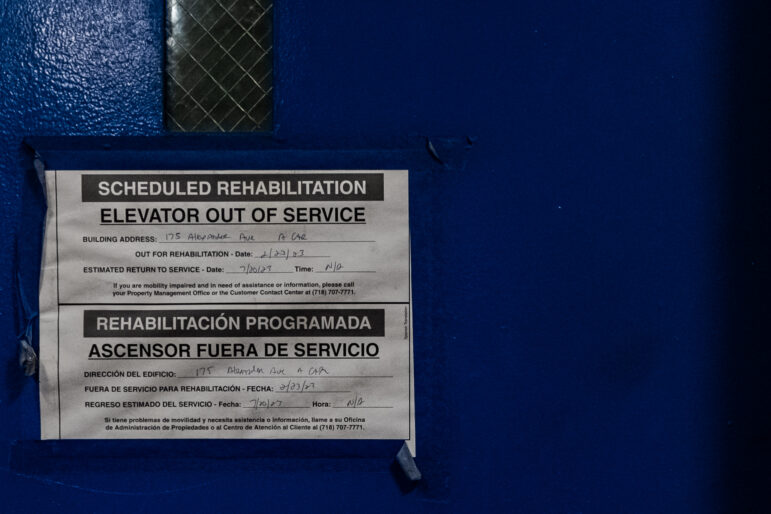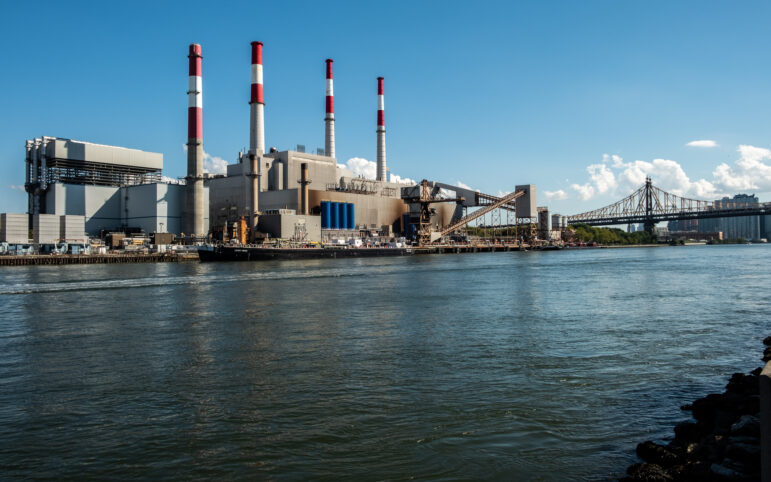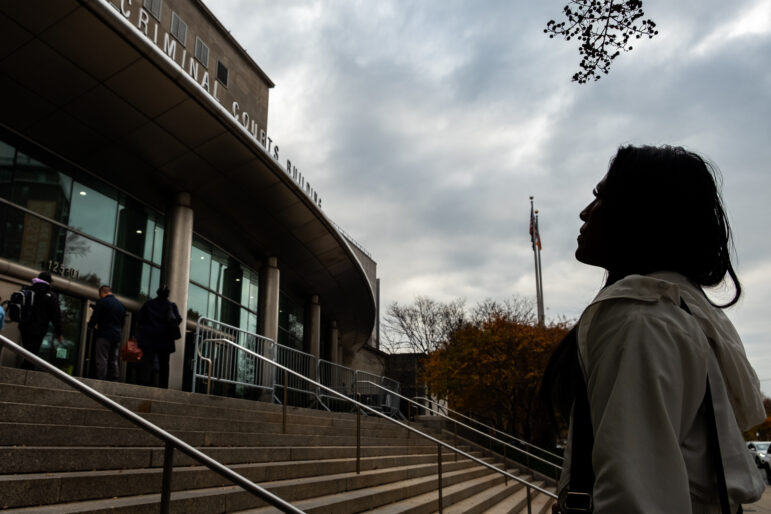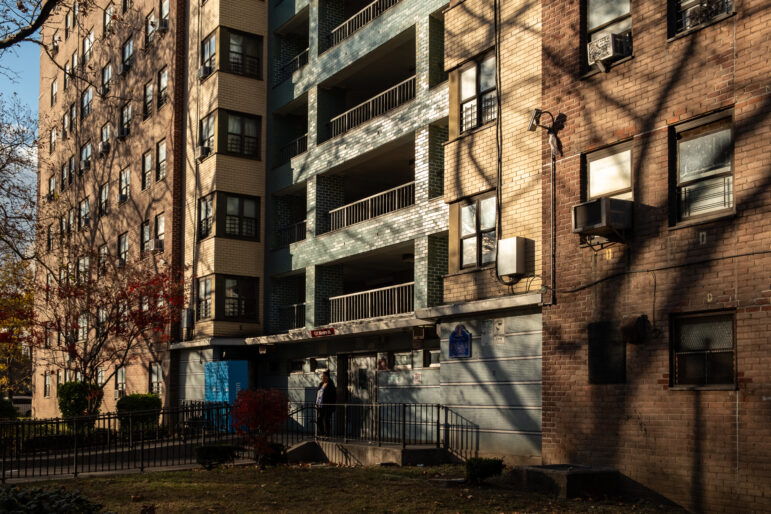Bronx borough command had given the nod several weeks beforehand. Deputy Police Chief Thomas V. Dale would appear that Tuesday morning in early April at a youth forum at Samuel Gompers Vocational & Technical High School in the South Bronx. Students would ask questions, Dale would answer, and hopefully a rare dialogue would emerge between the police and Bronx teens.
But moments before heading onto the auditorium stage, Dale peeked into the room, then ducked out, snubbing some 200 students. The forum went forward anyway, with teens putting questions like “Why are we judged by what we wear?” to three other panelists and Dale’s empty chair.
The kids weren’t the only ones who got jilted that day. Dr. Hillary Gaston, a high school history teacher at Gompers who is also pastor of Parkchester Baptist Church, had to explain to the disappointed audience that Dale had been spooked by the assembled television cameras.
For Gaston, who had arranged the forum, the deputy chief’s no-show was more than just a disappointment. It was a testament to how stubbornly difficult it is to try to mediate between police and civilians at a time when tensions are at a snapping point.
Healing that fractured relationship between cops and communities is an increasingly critical mission for Gaston and about 70 other religious leaders in the borough, who came together, just days after the police killed Amadou Diallo last year, to form the Bronx Clergy Task Force. When the four cops who shot Diallo were acquitted in February, task force members went out onto the street that night and literally put themselves between police and angry demonstrators. In the weeks that followed, the task force became famous–and parishioners told pastors stories of racial profiling, like that of one teen, thrown against a wall and arrested by an officer for no offense other than walking to a girlfriend’s house while wearing a Walkman, beeper and hooded sweatshirt.
The NYPD has turned to the clergy too. Thanks in part to Gaston’s 10 years on the Baltimore police force, the department sees the task force as cop-friendly. Chief of Department Joe Dunn, now the NYPD’s highest ranking uniformed officer, calls clergypersons “major conduits” to community goodwill.
With tensions high and dialogue nonexistent, the clergy have taken it as their mission to bridge the police and the people, and call for the NYPD to play a more positive role in neighborhoods. It’s not just because someone needs to keep the peace. Deeply trusted by residents, and respected by police leadership as emissaries of the only authority mightier than themselves, they are probably the only people in New York who can do it.
_______
Though it was born of a politically charged moment, the Bronx Clergy Task Force hardly came out of nowhere. It’s part of a long tradition of faith-based community organizing and mediation. “Look, whenever there’s any problem you go to the church. The civil rights organizations were always looking to the church for guidance,” says Karen Washington of the Northwest Bronx Clergy and Community Coalition. “When things were going haywire, it was the church you looked to for healing.”
So, as Bronx residents rally against police tactics, church leaders have taken up the cry. Their success keeping the peace in front of Diallo’s Wheeler Avenue building earned them a meeting with Police Commissioner Howard Safir, and the Task Force made the most of it, announcing that it wanted a return to community policing program in the Bronx.
If it happens, it would mark the return of a style of law enforcement that cut crime without alienating neighborhoods in dozens of cities, from Boston to San Diego.
Though the term has been distorted to include quality-of-life crackdowns and militaristic maneuvers, at its heart community policing emphasizes neighborhood involvement in crime prevention. Ideally, it relies on coalitions of citizens, business owners, block associations, clergy and of course cops working together to keep crime down.
The marriage of cops and collars isn’t as unlikely as it seems. During an epidemic of youth violence that culminated in a stabbing during the church funeral of a gang member, some 40 Boston churches came together in 1992 as the Ten Point Coalition. The group convened community meetings to find out why the stabbing took place and how it could have been prevented.
“We realized what could happen if members of the community could build relationships with kids on the streets, first of all, and with police as a result of their experiences on the street,” says Reverend Jeffrey Brown, who cofounded the Boston coalition.
Working in the coalition’s favor was the Boston police department’s commitment to community crime-fighting, introduced there by former NYPD Commissioner William Bratton. Brown says he and other clergy would run into gang unit officers who clearly knew that their job was to preempt violence and strengthen neighborhoods. Clergy, social workers, and police and probation officers would meet at churches to talk about whether a particular kid needed a job, some spiritual guidance, or a little time in jail.
In a change law enforcement experts attribute in part to the city’s strong community policing, Boston saw a 77 percent drop in homicide rates between 1990 and 1998, from 152 murders to 34–the third biggest decline in the country.
Not surprisingly, Boston is also not riven by misunderstandings. “When you don’t have a joint understanding on what’s going on in those very streets, you have Dorismond or Diallo,” Brown explains, “with these Street Crimes units coming up on someone because they don’t have any knowledge at all of who the community residents are. You have disaster.”
_______
The Task Force is highly aware of the Boston coalition’s success. The Bronx group wants to use similar techniques here, helping the police do their jobs without trampling on residents in the process.
One goal, of course, is to avoid more Dorismond-style disasters, in which law-abiding citizens are mistaken for drug dealers. Regular meetings between neighborhood, clergy and police would help steer the police toward the actual criminals–and away from those whose only crime is, as Gaston puts it, being “young people walking down the street, running off at the mouth and being teenagers in the year 2000.”
Some other demands include redeploying squad car officers to foot and bicycle patrols; using church networks to publicize police community council meetings so people can talk to precinct leaders about what they see on the streets; and getting special training for officers serving immigrant communities. Gaston would also like to see clergy involved in the NYPD’s training curriculum–especially in diversity and sensitivity training.
Some of these demands are sure to be unpopular with Safir’s NYPD. To get them through, clergy are counting on their ace in the hole: their proven ability to stop a near-melee in its tracks. Their power to calm angry community residents is a force even the police must reckon with.
“They were calling the police murderers,” says Raymond Rivera of the Latino Pastoral Action Center, recalling the scene on Wheeler Avenue. “We asked the police to step back and they wouldn’t. Finally the crowd turned around at our advice.”
But top NYPD brass are a tougher crowd. For two hours on March 29, Safir and five of his commanders met with the task force. Though the meeting was productive, it showed the task force how far they still have to go. “The commissioner made a case for the department really trying to diversify,” said Pastor Charles Kavanagh of Castle Hill’s St. Raymond’s church. The sticking point came when police downplayed civilian concerns, emphasizing the low number of police shootings last year. “That was the tension,” he says.
For now, the task force is tallying incremental changes. Bronx NYPD chiefs have consented to allow clergy to attend roll call before officers go on patrol. The same day he was stood up by Dale at the youth forum, says Gaston, he was very well received at Soundview’s 43rd precinct.
Boston’s Reverend Brown has advice for the New Yorkers. “You have to be committed for the long haul. That’s why faith-based groups are the most prepared for this job,” he says. “There’s a deep and abiding spiritual commitment there that causes them to see this thing through from start to finish.”
Jill Priluck is a Brooklyn-based freelance writer.








